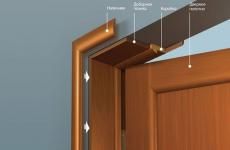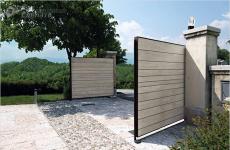Awnings - French curtains in the photo in the interior with a description. French curtains: types, materials, examples in various colors, styles, design, marquise decor French curtains in the bedroom interior
And the living room is the best option for fans of the classics in the interior. French curtains in the interior are found not only in city apartments, but also in country mansions.
Advice! A high-quality French curtain will equally perfectly fit into a romantic and classic interior.
You can create such a structure with my own hands, taking into account the specifics of the decorated room.

Rules for choosing material for French curtains
Craftswomen can purchase both airy light tulle and thick curtain fabric for work. Among the main requirements that are put forward to the matter purchased to create high-quality French curtains in the living room, we note the possibility of drapery. The appearance of the folds depends on the texture and density of the fabric.

For correct selection fabrics, it is necessary to be based on the following operational and external characteristics:
- delicate and dense fabric is suitable for creating falling waves;
- for volumetric folds, rigid and weightless matter is needed;
- French curtains for the kitchen are better to sew from organza
Interior professionals pay special attention to the choice of fabric with a pattern. There is a risk of getting "ripples", which will then be lost in the folds, which will spoil the external impression of the finished curtain.

Advice! The best option for kitchen French curtains - plain lightweight fabric: silk, organza, satin, chiffon.
With the help of a finished curtain in the kitchen, close the window in working area. An interesting addition to the created image will be the use of a beautiful lambrequin.

Rules for calculating fabric for sewing
French curtains in the interior involve the use of a significant amount of material, as it is necessary to make drapery and beautiful waves. To calculate the usual curtains, the width of the window opening, as well as the size of the decorative cornice, are taken into account. And for the manufacture of French curtains, the degree of assembly is used, which cannot be less than two widths of the fabric itself.

Advice! It is necessary to take into account the length of the cornice, adding 5 cm on each side of the curtain (for seams). The rest of the fabric is used to create beautiful folds.
The length of the finished curtain is multiplied by 2, seam allowances are added, which are 5 cm for the bottom of the curtain, 3 cm for the top.
There are certain similarities between French and Austrian drapes, but they differ in the amount of fabric used.

Pattern Features
French curtains, photos, pattern options, helpful tips, all this can be found in the video fragment
Tailoring consists in choosing a drawing, as well as strict adherence to a certain sequence of actions. Decating is done first. It involves processing the fabric in order to prevent its subsequent shrinkage.

The procedure for decathing is quite simple and understandable. The fabric is soaked for 10-15 minutes in warm water, then carefully outlived, dried.
The algorithm for sewing French or in the living room can be represented as follows:
- Processing the top and bottom edges of the curtains. It is convenient to place the fabric on the floor, make 1.5 cm folds on the sides, then hem the curtains.
- From below, the porter is folded two centimeters, the edge is hemmed.
- Next, you need to mark the drawstrings. Using a ruler, you can get equal gaps along the entire length of the curtain.
- The formation of the wings is carried out using fabric cuts. A fabric with a width of 3 centimeters is sewn along the marked lines, folded inward on the sides.
- The curtain on the balcony or in the kitchen should be regulated by a cord that is threaded into the drawstring.

For the manufacture of French curtains, a sketch drawn up in advance is used. IN finished structure includes several components.
Advice! You need to choose a model not only based on personal preferences, but also taking into account style direction used to decorate the room.

Drapery can be done in rings. Rings are sewn on the drawstrings after 15-20 centimeters. In order to achieve high-quality fastening curtains on the eaves, professionals recommend using a strong tape.

Simplified version of French curtains
On the balcony you can see a version of the curtain, made on their own. In order to cope with the task, it is necessary to take into account five basic rules: calculate the fabric, mark the scallops, outline the undercuts, fasten the curtain tape to the markup, pull out the cord, and achieve uniform drapery.

Even without sewing skills, it is quite possible to make simple model French curtains for decorating the balcony. Currently, there are two options for curtains: lifting and static. Lifting models operate on a rotary-chain mechanism, and static curtains cannot be moved.

Such curtains are suitable for baroque, empire, classical style. In the living room, they will emphasize the conciseness of the interior, in the bedroom they will help create a romantic atmosphere, and in the study they will demonstrate the status of the owner of the premises.

Such curtains appeared in the 18th century in France, only expensive fabrics were used for their manufacture, so you could see French curtains only on the windows of noble mansions.

At first, awnings were used to curtain windows in palaces, theaters, and restaurants. Currently, they can be seen both in city apartments and in country mansions.
The splendor of the curtains allows you to use them for decoration window openings in the bedroom, living room, kitchen. French curtains can also be seen on the balcony windows.

Light curtains with soft and even folds will become a real decoration of the window in the bedroom, fill the room with romanticism. To make a similar design, you can first make a line along the entire length of the curtain, then gently tighten the laces, getting a uniform canvas.
Advice! In the kitchen, it is better to choose a curtain along the length, which will be just below the windowsill. In this case, the curtain will not interfere with the cooking process, while cleaning the room.

Conclusion
The effect that a French curtain will produce depends on the texture and type of material used in its tailoring. For example, if the room has high ceilings, you can choose dense expensive fabrics, they will help emphasize the sophistication of the room, the status of the owner of the apartment.

For work you will need a veil, organza, cambric or silk. The choice of fabric depends on the financial capabilities of the owner of the apartment, the design of the room, as well as on personal wishes.

In order for the curtains to turn out beautiful and practical, you need to remember about the allowances for the seams, as well as the fact that the length of the fabric should be twice over size finished product. Only if these simple rules, you can count on tailoring a beautiful French curtain for the kitchen or living room.
Even during the reign of Louis XIV, French curtains were in vogue, but even today they do not lose their place in any interior.
These curtains are used by many luxurious establishments, theater houses and even wedding palaces. IN home interior they also have a special place.

Today, history does not tell which of the designers was the first to create this masterpiece. It is because of the luxury and wealth that the second name of the French curtains is “marquise”.

To sew a French curtain, you only need a not very large fabric flap and sew a braid vertically along it, thread all the cords and collect the material into the so-called scallops. From such a simple patch, you can make a magnificent decoration in the room, which will not only cover the window, but also stylishly decorate your home.

If such ready-made French curtains are hung in the bedroom, then it will look like royal chambers.












Many people get confused between the difference between Austrian and French curtains. They differ in that the Austrian has only a wavy bottom, and the French wavy completely.

Looking at the curtains in general, you can understand that they differ in length. Divided into types: stationary and lifting.

The stationary view of the French curtain completely occupies the entire window, and is a tulle. Therefore, they are made from fabrics that let in daylight. Such fabrics are light and light colors.

If we consider a lifting curtain, then they differ from a stationary one only in that they have a latch that regulates the length of the entire curtain, as well as the number of folds on it.
The right choice of fabric
To create a large volume of curtains, you need to use the lightest fabrics when sewing. Under the reign of Louis XIV, designers used different silks or cambric.

Later, in Russian Empire tulles were used. But new productions began to use the option of curtains with organza. Also do not manage and polyester. This option has an excellent structure, practical, and easy to care for. You can find polyester curtains in different rooms.

They not only decorate the window, but also protect against ultraviolet radiation. The velvet design of the French curtains is relevant in the interior, creating a fabulous atmosphere.

To make beautiful French curtains, you need to take elastic materials, because after assembling them, they will give a lot of volume.

French curtains in the interior are a great luxury, and they look very beautiful and festive. They are mainly used as decoration for the room, since the quality of the material requires special attention. French curtains will also add aristocratic and sophisticated look to the hall or living room.

If desired, these curtains can be used in your bedroom, and a short version in the kitchen. But for the bedroom the best choice will become tulle. haze of pink or blue color makes the room even more romantic.

An interesting fact is that curtains of this type will add luxury next to a modest sofa or armchair. Pour into the design of expensive furniture.


DIY French curtains
You don't have to spend a lot of money to buy different models curtains, as you can sew them with your own hands, and decorate the kitchen with them. The first thing to do is measure the window. Multiply the width by 1.5, the length by 2. This is how we find out how much fabric is needed.

After you have decided on the choice of fabric, you need to hem the sides of the seams, as well as the bottom. Next, you need to mark the strips of fabric, the width of which is 3 cm. Thread and fix the cords and strips from above. Fasten to the cornice with a wide ribbon or wide loops.
How to care
Dust accumulates on the scallops and this is the main problem. But a simple vacuum cleaner can solve this problem. Stains on the curtains are removed with a simple washcloth, moistened with a solution of soap.

Tulle or organza curtains can be machine washed, but velvet fabrics are best taken to the dry cleaners.

Photo of French curtains in the interior








Luxurious, rich, stylish, solemn - any of these epithets can characterize French curtains. Smooth lines, lush arched draperies, flowing vertical rows soft scalloped folds combined with a light texture of delicate fabric and magnificent curtain accessories leave no one indifferent. Looking at them, even the most staunch adherents of laconic interiors begin to think about decorating at least one window in the house with beautiful “French women”. What is the secret of the centuries-old attractiveness of such a phenomenon as French curtains and how they differ from other lifting curtains, we will understand in this article.
History of appearance

It is believed that the description of the first curtains with scalloped folds laid along the entire length appeared in the 17th century in France during the reign of Louis XIV - King - the Sun in the heyday of baroque and classicism. Who exactly came up with decorating the windows not with straight lines, but with canvases gathered along the entire length in cascading rows of festoons, history is silent. Nose light hand by an unknown designer, such curtains for windows quickly gained popularity among the nobility and became the personification of wealth and luxury. They were sewn from natural Chinese silk and decorated with fringe and tassels.

For "French" fabrics, several times more is required than for straight curtains, in addition, numerous scalloped folds do not look on cheap textiles and small windows. Therefore, it is quite clear that ordinary people they were not available, and the people called them "marquises" - by analogy with one of the highest European noble titles.
 Officially, "marquise" is called a fabric canopy for protection from the sun and rain.
Officially, "marquise" is called a fabric canopy for protection from the sun and rain. The second unofficial name has been preserved behind the curtains by aristocrats to this day and leads to confusion of concepts. The fact is that officially awnings are called fabric awnings over windows, used to create a comfortable shaded area on the street in front of houses, cafes and restaurants.

In its original form, the curtains of the marquise are stationary (they do not move apart, do not rise, but simply hang motionlessly to the floor), they look very solemn and pompous and look best in spacious rooms with high ceilings. Therefore, today they are used mainly on stage, in concert and banquet halls, restaurants, spacious halls of country houses.

For owners of average apartments, options for French curtains have appeared, sometimes they are called French blinds, adapted to modern realities:
- Firstly, the length of the canvases was significantly shortened and, for example, in the kitchen, you can hang a French curtain up to the windowsill.
- Secondly, in addition to natural silk, many high-quality, but not so expensive fabrics have appeared today, on which scalloped folds also look attractive: organza, chiffon, cambric, moire.
- Thirdly, cornices for French curtains began to be equipped with lifting mechanisms, both with manual and electric control, which can be mounted on hinged windows, which significantly increased their functionality and expanded their scope.
What are modern french curtains
French curtains (marquises) - a cascading variety of lifting curtains. But unlike other lifting models, they do not come to the fore with practicality and functionality, but with beauty and the difference in their appearance obvious. At the same time, it is impossible to confuse French blinds with strict Roman blinds with their characteristic even linear folds and laconic rolls, on which there are no folds at all. But they have much in common with the Austrian models: the canvases are divided into vertical sections and assembled into arched folds. French and Austrian curtains the photos below clearly demonstrate the difference between these two species.

The difference lies in the fact that the draperies of the Austrians are not so plentiful: they are formed only in the lower part and are much wider. When unfolded, they are completely straightened, and their length never falls below the window sill. Awnings are curtains, even in the lowered position, consisting of a large number, divided along the entire length into vertical segments of cascading scallops (sagging towards the center of the assemblies). When the curtain rises, they become even deeper and more expressive.
The length of French curtains can be set to any length, both to the window sill or just below it, and to the floor. In addition, they are divided into stationary (fixed) and lifting:

Cornice for French curtains
The cornice for French curtains can be the same as. Depending on the model, it is equipped with a lifting mechanism or a simplified version is dispensed with. At the same time, the fastening of the canvas can be on Velcro tape or on hooks. The photo below shows standard curtain rods for French curtains with an open and closed curtain lift mechanism.

It is worth noting that no matter what fabric (thick or transparent) was used for tailoring, thanks to the abundant and complex drapery, the marquise is able to completely protect the interior of the room from views from the street.
What fabrics are suitable for French curtains
French curtains in the interior are far from the best economical way window decorations. They require fabric several times more than for ordinary curtains. In addition, scalloped folds on cheap fabrics look ugly and primitive, and, despite the fact that modern awnings do not have to be sewn as they used to be from expensive natural silk, it will not be possible to significantly save on textiles either.
Before choosing to French version curtains, it is advisable to properly weigh the costs of their manufacture and make sure that they fit well into the interior and the money spent on them will be compensated by the beauty and harmony of the situation.
To make the folds look spectacular, be even and smooth, you need to choose a well-draped, light and soft tissue. These conditions are best met by natural or mixed, with a small addition of polyester fibers, textiles:
- tulle;
- thin silk;
- chiffon;
- batiste;
- moire;
- muslin;
- veil;
- organza.
Such curtains look light and delicate and are used as curtains, both independently and together with curtains made of taffeta, satin, velvet, brocade. At the same time, curtains should also look luxurious and not be lost in the splendor of French curtains.
 French satin curtains
French satin curtains Sometimes awnings are also sewn from dense, but thin, soft and well-draped fabrics. It could be:
- velvet;
- velours;
- curtain wool.
Such curtains do not need partners and look elegant and respectable. Any curtains hung with them would be redundant. But you need to keep in mind that windows with dense opaque awnings look "deaf" and they are only suitable for spacious rooms and corresponding to them in status classic interiors with massive furniture natural wood and gilded or bronzed accessories.
 French velvet curtains
French velvet curtains The appearance of the folds depends entirely on the texture of the fabric: the softer and heavier it is, the more concise and smoother the scallops are. And, conversely, the harder and lighter the material, the more magnificent and embossed they are.
As for the colors, only plain fabrics are suitable for this type of curtains. Any drawing will be lost in numerous scallops, it will look broken, and the curtain will be untidy.
Which rooms and interiors are awnings suitable for?
 French curtains in the bathroom
French curtains in the bathroom Pompous and aristocratic French curtains will not fit into every room. Cascading vertical rows of scallops, expensive fabrics, accessories in the form of fringes, tassels, flowers and beads will look ridiculous and cumbersome on small windows in small rooms and modest interiors. Best of all, "Frenchwomen" look in an exquisite romantic setting of rococo and baroque in the spirit of the 17th-18th centuries with artsy, smoothly curved furniture, crystal chandeliers and bronze figurines.
 French curtains in the interior of the living room
French curtains in the interior of the living room Of course, few people today would think of creating an interior in their home that completely copies the atmosphere of past centuries, but its main signs and general style must be respected. If you want to decorate a small room with awnings, use options adapted to modernity and performing the function of tulle - from transparent white or pastel shades fabrics, up to the window sill, without additional decorations.
 French curtains in the office
French curtains in the office So that the light tulle French curtain does not “play” from the draft and hangs statically, to its bottom edge you can sew on special weights.
 A short French curtain complemented by an original pelmet on the kitchen window
A short French curtain complemented by an original pelmet on the kitchen window Concerning functional purpose rooms in which it is planned to hang curtains of this type, it can be anything - the main thing, as already mentioned, is the surroundings corresponding to the marquise. Of course, French curtains look best in the living room or office, but they are used no less often in such non-residential rooms as the bathroom and kitchen (as in the photo above). The only room where their use is undesirable is the nursery. No matter how attractive the “Frenchwomen” are, dust inevitably accumulates in numerous scallops and they often have to be washed, so curtains that are more functional and simple in shape are appropriate for the room where the kids live.

Despite their aristocracy and sophistication, French curtains can make the interior not only elegant, but also cozy and peaceful. The main thing is that they should match the interior and look, and it will help to increase their functionality. modern mechanism with lifting block.
Video: French curtains in the interior
[Rated: 3 Average rating: 3.7]
French curtains are distinguished by the presence of several sections and fluffy folds of fabrics falling down along the entire length. Curtains can be long, medium and relatively short (these are usually used for kitchens).The first type is static curtains. They are also called stationary. They are not always convenient to use, as they hang motionless. Their design does not provide for movement up or to the sides. Usually such curtains are made of light translucent fabrics and perform the function of tulle.
The second type is lifting curtains. They are more common than stationary. With the help of a special clamp, you can adjust their appearance and length. You can lift the curtains up, then even more folds will form, and they will be more magnificent.
French curtains in the interior
Best of all, these curtains are suitable for spacious rooms. In order for them to look good in a small room, it is important that they are not very lush, and there are not too many folds.If the room is decorated in modern style - such curtains will become its integral part. If the bedroom is decorated in this style, curtains will look good. different lengths. This will give the room a casual and romantic feel.
Also, French curtains will look good in a room that is decorated in classical style. Especially if there is classic or antique furniture, then such curtains will only add solemnity to the interior.
DIY French curtains
Of course, it will not be difficult to find and buy French curtains. But if a person has some sewing skills, you can do them yourself.First you need to decide on the fabric. It can be thin cotton or linen, silk or satin. The next thing to do is to calculate the fabric consumption. To do this, measurements of the window are carried out and, based on the results obtained, it is calculated how much tissue is needed. For this, the following is used: the width of the window must be multiplied by one and a half, and the height by two.
When sewing curtains, it is important to follow a certain order:
1. Before starting work, the fabric is processed and the decathing procedure is carried out.
Decating is a wet-heat treatment of fabric for its shrinkage.
2. After the fabric on the floor. On the sides, bends are made twice 1-1.5 cm wide and hemmed.
3. At the bottom of the fabric, a 2 cm wide hem is made and also hemmed.
4. Cords are threaded into hemmed seams.
5. After the drapery is performed. Markings are made along the width of the fabric every 45-50 cm, and then a piece of fabric 3 cm wide is sewn vertically, bending the edges inward. Thus, the drawstrings are formed. Cords are threaded through them and fixed at the top. The bottom ends are free.
6. A tape is sewn in the upper part of the canvas to secure the curtains to the cornice.
In addition to their luxury and pomposity, French curtains add calm and comfort to the room. And they always unobtrusively pay attention to the wealth and success that reign in the house.
Usually, the fabric for French curtains is chosen in a single color, but in exceptional cases, a fabric with a light, unobtrusive pattern can be used.
Usually, the fabric for French curtains is chosen in a single color, but in exceptional cases, a fabric with a light, unobtrusive pattern can be used.
The owners of French balconies are definitely lucky - the panoramic glazing of the loggia creates a delightful feeling of spaciousness and freedom. But it is impossible to admire the views endlessly, so you need to choose curtains for such a balcony so as not to feel in front of everyone. After all french loggia It will be a great place to relax, and maybe even for an office. What frame to choose for a balcony with panoramic windows? Let's look for inspiration in photographs showing good ideas design!






Principles for choosing curtains for a French balcony
Perhaps you should immediately understand the terminology. It so happened that a French balcony means two architectural solutions: a small single-leaf balcony (traditionally with a forged fence) and a spacious loggia with floor-to-ceiling glazing. In this case, we mean the second option.
Glazing features french balcony to a certain extent, the principles of choosing a frame also dictate:

Design ideas for a French loggia
The variety of interior solutions invented by designers for balconies with panoramic glazing can give rise to a well-known psychological phenomenon - “stupor” with an excess of choice. This phenomenon is often observed in supermarkets: there are so many products that the buyer does not know what to choose! And in the end takes the usual brand. To solve this problem, you should first decide how exactly you will use panoramic balcony and then take a close look at the benefits of different design ideas.
If the French loggia becomes a relaxation area for you - say, with a deck chair or a coffee table - light curtains are best suited. An excellent choice is thin silk or cotton fabrics of light, pastel colors falling in straight lines. You can intercept the curtains with tiebacks: in this case, the balcony will provide an excellent view, but the feeling of the “aquarium” will disappear.



If you are going to equip an office on a French balcony, choose concise solutions that do not distract from work. For example, a light tulle that allows access to light, but hides you from the views from the street. However, it must be remembered that when the light is on, the entire loggia will be in full view. A combination of tulle with more thick curtains for evening time. Another interesting proposal is the combination of cozy wooden blinds with light chiffon or organza curtains.



Very convenient option for the French balcony - roller, Austrian and Roman curtains. At any time, you can raise them and enjoy the panorama that opens up.



Finally, if the loggia is spacious enough, panel Japanese curtains will look great in it. Evaluate this option - you might like it.











